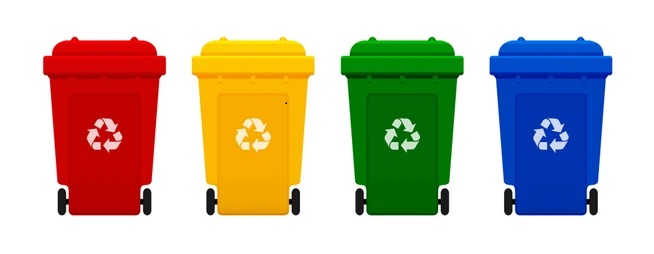Red, Green and Blue Dustbin
There are many different types of dustbins that denote different wastes. Here we will discuss the differences between red, green, and blue dustbins.
Nowadays, waste generation and disposal have become a matter of concern due to an enormous increase in population, urbanisation, and industrialisation. Landfills are also another problem for waste disposal as their area is very low and decreasing day by day. Waste segregation minimises the risk of human health, social life, and the environment. Waste segregation is the sorting and separation of waste for recycling and easy disposal of waste. It was done by the use of colour-coded dustbins like red, blue, green and black etc. As the government alone cannot deal with it, every individual should take a step forward. When all the wastes are collected together, it will be difficult to deal with, so the idea of using colour-coded dustbins was promoted to make recycling easy. These dustbins differ in the waste they collect.

Red Dustbin
It is used for waste that is not biodegradable. It is also regarded as rejecting dustbin as these wastes cannot be recycled. It is usually placed in hospitals and used to collect biomedical wastes, which are dangerous to deal with and consists of needles, surgical knives, body fluids, cotton dressings, pop casts, tissues, sanitary napkins, etc., which are to be disposed of carefully. If not disposed of properly, diseases like HIV, Hepatitis B and C will be transferred through the pricking of infected needles. It contains both hazardous and non-hazardous wastes. As these waste materials cannot be recycled, they are taken for incineration.
Green Dustbin
It is used for wet and biodegradable wastes. It is also referred to as an organic bin as it contains wastes from kitchen, plant and animal origin. These wastes comprise rotten eggs, fruits, vegetables and peels, coconut shells, tea bags, used tea powder, left-over food, garden waste, etc. Organic waste is also used as manure in the kitchen garden to grow vegetables. Some of these wastes are sterilised and fed to animals, and farmers use the remaining waste for manure and composting, which helps in improving the fertility of the soil. This waste is turned to zero waste through composting. Sometimes if plastic wrappers are mixed with this waste and if, unfortunately, animals eat, it leads to the death of the animal. So the disposal of waste should be done carefully. Some materials are difficult to differentiate between dropping in dustbins. For example, in the case of biscuit packets with biscuits, then the biscuits should be dropped into a green dustbin, and the biscuit wrapper is to be dropped in a blue dustbin. Expired or spoiled food should be removed and then discarded. These wastes become more problematic only when they are in excess. Foul smell is released from this organic matter, which leads to human diseases on inhaling.
Blue Dustbin
It is used for dry and non-biodegradable wastes. Dry waste means literally dry, i.e., if the paper is dry, it is thrown in a blue dustbin and thrown in a green dustbin if it is wet. Liquid wastes are removed, rinsed, and the plastic wrappers and covers are dropped in the dustbin after drying. As microorganisms cannot break down this waste, it is called as non-biodegradable waste and it is to be recycled. If not disposed of properly, they cause pollution and harm the environment. Materials like plastic, aluminium cans, polystyrene, newspapers, paints, aerosol cans, lights, broken bulbs, glass bottles, plastic bottles, gift wrappers, cards, cardboards, thermal coal, tetra pack packaging etc., are to be thrown in this dustbin
These wastes are recycled and used again; through this, the garbage to be dumped in the landfills also decreases, and there will be less impact on the groundwater level. Other wastes like electronic devices regarding iron boxes, mobiles, TVs, computer systems, led bulbs, CDs, pen drives etc., should not be dumped into the blue dustbin; instead, they should be handed over at e-waste collection centres. Thus the work of waste sorters is made easier and more efficient. Thus the waste can be reused and reduced.
Conclusion
Waste segregation plays a major role in waste management. The Government and NGOs play an important role in creating awareness about waste segregation and the slogan of waste management 4 R’s, i.e., Reuse, Recycle, Reduce, Refuse, for proper waste management. It is communicated to the public easily through awareness campaigns, social media, radio, newspapers etc. At a personal level, waste segregation should be started at every household, and they should make use of red, green, blue dustbins. Proper disposal is also important. Stringent measures should be taken for segregation, transport and proper disposal of wastes. Right rubbish in the right dustbin should be our motto.
Note: Specifications are subject to change without prior notice due to continuous product development and images. All pictures shown are for illustration purpose only. Actual product may vary due to product enhancement.
Because this item is not stocked in our warehouse, processing, transit times and stock availability will vary. If you need your items by a certain date, please contact us prior to placing your order. Expedited shipping availability may vary. We cannot guarantee that this item can be cancelled off of the order or returned once it is placed
More Details: www.avnthospitality.com | Blog | Hair Dryer | Electric Kettle | HK Trolley | Minibars